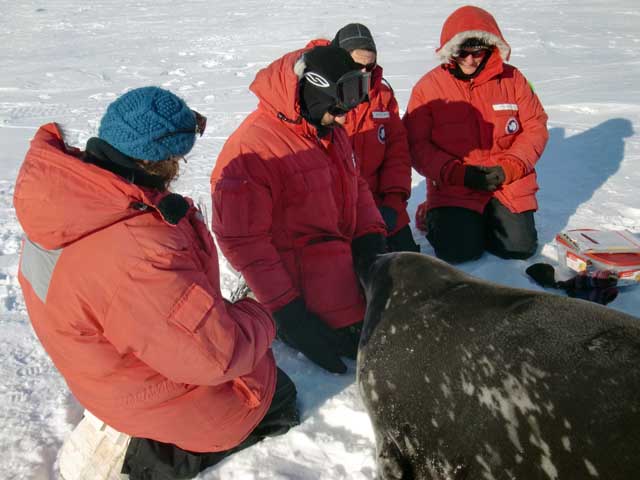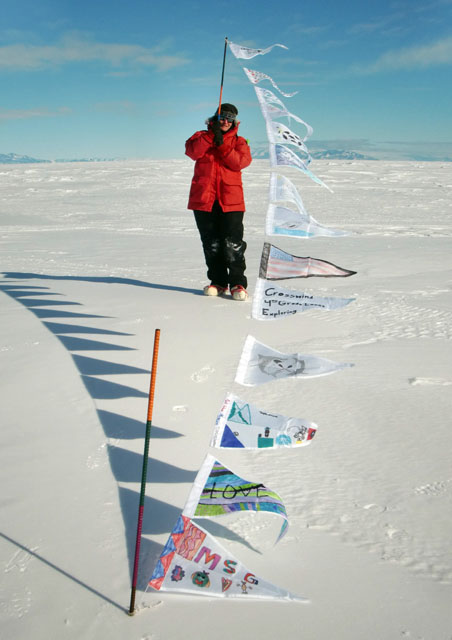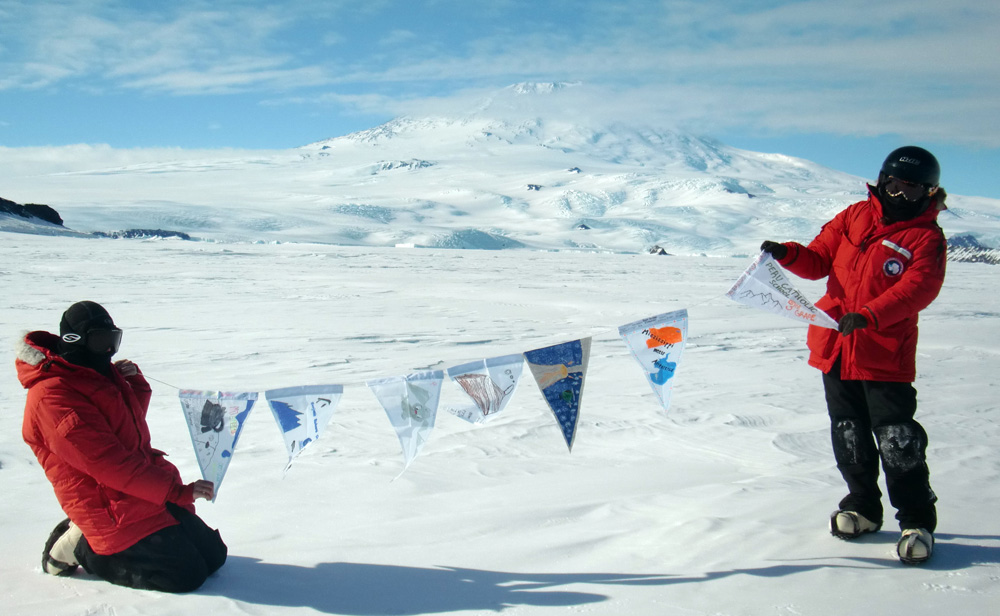Reaching outEducator teams up with seal biologists to teach kids about science in AntarcticaPosted December 5, 2014
Memphis is a long way from McMurdo Station in Antarctica, but Alex Eilers has brought thousands of students, teachers and others along on an expedition to study Weddell seals. In fact, it’s exactly 8,764 miles as the crow – or in the case of the Antarctic, the skua, a seabird scavenger – flies. Eilers knows the exact mileage because that factoid is one of the many ways she is helping bring research in Antarctica to classrooms in Tennessee and several other states. The manager of education at the Pink Palace Museum in Memphis, Eilers first came to the Antarctic in 2012, as part of PolarTREC NSF-funded research
Jennifer Burns and James Ward Testa, University of Alaska Anchorage,
Award No. 1246463.
Marine Mammal Protection Act #17411.
Eilers had been a member of a team of scientists – led by Jenn Burns, Daniel Costa and Eileen Hofmann – investigating the winter foraging strategies of Weddell seals. This year, she’s rejoined Burns on a new project studying what drives the timing of certain critical life events of the seals, such as breeding and molting, and how future climate changes might affect that cycle. [See previous article — The Weddell's new coat: Scientists study how biology and environment influence seal molting, breeding.] While not one of the dozen educators sponsored directly by PolarTREC in 2014, Eilers is collaborating with the organization and providing journals, pictures and video on a webpage “It was hugely successful back home,” Eilers says, referring to the 2012 adventure, reaching more than 15,000 people, mostly elementary and middle school kids. “It was literally the most successful program that we’ve ever done, and now we’ve become part of the team officially.” In the team’s lab room at McMurdo’s Albert P. Crary Science and Engineering Center, Eilers is sorting through plastic bins stuffed with about 250 flags that had been decorated by students. Each pennant, sporting designs based on topics as varied as seal fur and glaciers, will be flown by Eilers during the team’s fieldwork in the coming weeks. Eilers will attempt to address the different topics in her PolarTREC field journal, eventually sending flags and photos back to the kids. “It’s just about doing a lot of fun things like that to get them connected and drawn into the journals,” Eilers explains. 
Photo Credit: Alex Eilers
Researchers gather around a Weddell seal female for a project looking at major life events like breeding and molting.
At last count, another 300 students are making that long journey from Memphis to McMurdo as part of a Get Fit challenge in which students earn a mile for every minute they exercise or study science. Eilers notes that obesity is a serious problem in Tennessee, with about a third of the population extremely overweight. “I’m trying to get fit on my journey down here, and I’m asking the students to follow along with me,” she says. In total, outreach efforts have reached 8,000 people so far, according to Eilers. “It’s growing exponentially, and we are just so thrilled,” she says. Eilers’ enthusiasm is infectious. Burns included Eilers in the project proposal as part of the team’s dedicated outreach efforts for this latest project. “There is an interest in NSF in doing outreach and reaching kids beyond the grad students that are associated with the project,” Burns notes. “I thought, ‘Here’s somebody I already know who is confident in the field, knows how to reach a large number of students.” Burns had a chance to see firsthand the results of the PolarTREC program during a visit to Memphis classrooms in 2012. “It was really fun to see all these kids who really jazzed about science and what we were doing,” she recalls. “At the same time, I realized that I didn’t really know how to do that well myself, because I’m trained to teach college-level students and grad students.” 
Photo Courtesy: Alex Eilers
More than 8,000 people have been reached this year through outreach efforts by Eilers and other members of Burns and her science team.
The effort has expanded beyond Memphis and Tennessee to Burns’ hometown of Anchorage, where she is a professor at the University of Alaska, with presentations by graduate students Roxanne Beltran and Amy Kirkham to more than 20 high schools classrooms. Burns is also teaching the university’s first Antarctic ecology class this semester in which undergraduate seniors are learning about terrestrial and marine Antarctic ecosystems, and are conducting a final research project on the Ross Sea ecosystem. She is doing a virtual lecture from McMurdo, and she has enlisted other experts at the station to do presentations. The outreach focuses on the Weddell seal project, but includes general information about Antarctica, as well as topics as varied as ice cores and volcanos. “We’re just trying to show the breadth of what’s out here,” Burns says. “I just hope people become aware of what’s going on around the planet.” There is also a focus on minorities, inner-city children and girls. Most of Burns’ team members are women. Women are well represented in some disciplines, such as biology, but the percentages are much lower in others, including physics and engineering. “There’s a big disparity across fields,” Burns notes. An NSF-sponsored report indicates that women now earn about 50 percent of the doctorates awarded in the biological sciences. By contrast, women earn less than 30 percent of doctorates in computer science and engineering. Eilers hopes to present the outreach program at the next National Science Teachers Association conference in 2015. She will also return with the team for the 2015-16 season. In between, she’ll continue to correspond with teachers and capture the imagination of every child she can. “It’s a lot of work, but I wouldn’t be doing this if I didn’t think it was important and needed,” she says. “It is so frustrating for the students to just sit there and not doing anything. They have to be active; they have to be hands-on or engaged. That’s what we’re trying to provide – that excitement.” |



For USAP Participants |
For The Public |
For Researchers and EducatorsContact UsNational Science FoundationOffice of Polar Programs Geosciences Directorate 2415 Eisenhower Avenue, Suite W7100 Alexandria, VA 22314 Sign up for the NSF Office of Polar Programs newsletter and events. Feedback Form |


